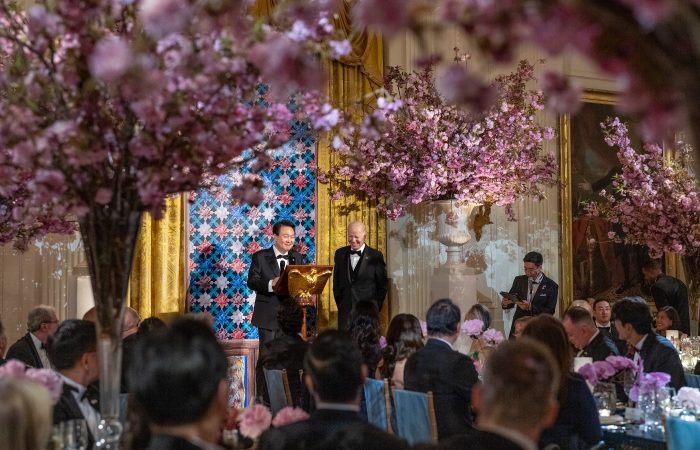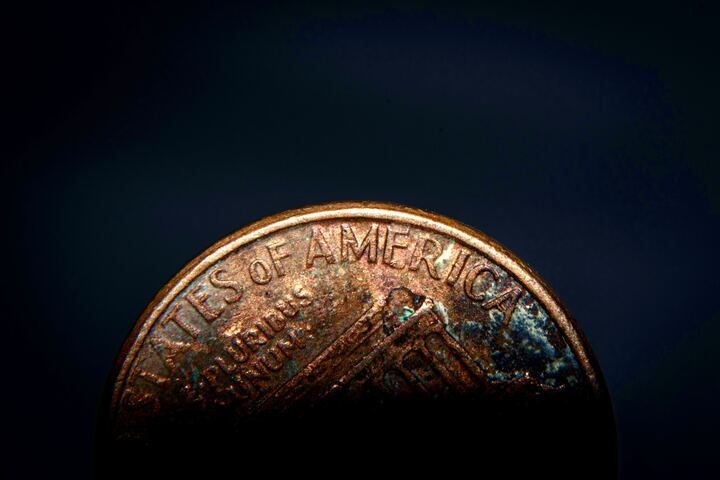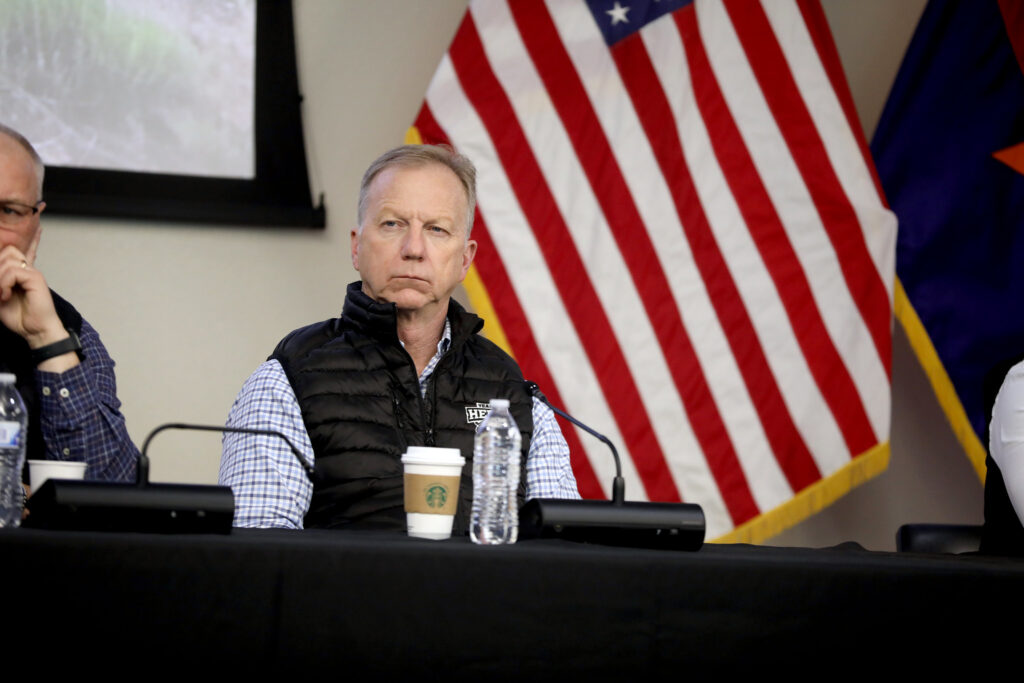South Korean President Yoon Suk-yeol is facing widespread and vigorous criticism following his state visit to the US on April 26 and his shuttle diplomacy attempts to normalize relations between the ROK and Japan, meeting Japanese Prime Minister Fumio Kishida in Tokyo on March 16, and again in Seoul on May 7. This criticism has not come from North Korea or China, as might be expected, but from domestic commentators concerned that Yoon is pivoting too much towards the US and is overly hasty in his approach to Japan.
The first issue is about nuclear strategy, for which President Yoon has recommitted to the Tailored Deterrence Strategy (TDS) proposed in the US Nuclear Posture Review of October 27, 2022. Some South Korean political factions would prefer the ROK to develop its own independent nuclear deterrent, and there is substantial public support for this.
President Yoon’s summit meeting with US President Joe Biden endorsed the so-called “Washington Declaration” which establishes a ROK-US Nuclear Consultative Group (NCG) and upgrades the ROK-US relationship into a comprehensive global strategic alliance, expanding its scope and mission beyond the Korean Peninsula. Many South Koreans are expressing deep misgivings that Yoon is leaning to much towards the US, and he has been punished by very low public approval ratings.
To support President Yoon’s recent initiatives, the ROK presidential office has relied upon a few unrepresentative conservative groups which characterize the prevailing domestic opposition as nostalgically emotional and naively dovish. Closer relations with Japan and the US are portrayed as essential to the ROK’s survival in dealing with the threats from North Korea and China.
The exact arrangements for the TDS and the NCG mechanism remain to be specified, however, and it is unclear how the ROK will be better protected. The role of the Extended Deterrence Strategy and Consultation Group in implementing these policies is also ambiguous, as is the promised more visible deployment of strategic assets to the Korean Peninsula. Indeed, the US decision to deploy an Ohio-class nuclear submarine (SSBN) in the seas around the Korean Peninsula is controversial. Since North Korea has declared its intention to strike first with its nuclear weapons if it feels that its leadership is threatened, the NCG may escalate current tensions between the two Koreas, especially if Japan is later included in an expanded trilateral NCG.
Another issue which has attracted severe criticism is President Yoon’s attempts to move beyond the historical difficulties which constrain the ROK’s present-day relationship with Japan.
Currently, the most salient historical impediment to improved relations is the status of Korean forced laborers during the Japanese occupation of Korea, though Japan also makes its own complaint, claiming that an ROK destroyer locked its fire control radar on a Japanese aircraft in 2018.
President Yoon has announced the “normalization” of the General Security of Military Information Agreement (sharing intelligence between the US, the ROK, and Japan), and following the Yoon-Biden summit it seems that the US administration has pressed Japan to make some goodwill gestures toward the ROK. The only evidence of this so far is the invitation of Yoon to the G7 Summit on May 19-20, 2023, which is widely perceived by South Koreans as too little and too late, considering the concessions Yoon has already made. The prospect of improved and stable relations between the ROK and Japan remains a distant one, while the domestic political situation in both countries is unreceptive.
From the ROK perspective, Japan continues to behave provocatively with its declared intention to release more than a million tonnes of radioactive water from the destroyed Fukushima Daiichi nuclear plant in Spring or Summer of this year. A scientific consensus supports the release, but it is controversial among ordinary South Koreans. The International Atomic Energy Agency will be monitoring the release, but the recent agreement that ROK scientist will also have access will help to assuage public feelings in the ROK. etc.
The establishment of the NCG between the ROK and the US offers an opportunity for Japan to change its stance towards ROK. Japan is wary of allowing the ROK-US alliance to become the top US priority, with the US providing extended deterrence which does not include Japan. Since it also faces North Korean nuclear and missile threats, Japan seems likely to show willingness to join an expanded trilateral NCG.
Another outstanding issue is how to integrate the Washington Declaration into several existing and proposed structures: the ROK’s Joint Chiefs of Staff (JCS), the Future Combined Forces Command (F-CFC), and the new OPLAN 5015, which must be rewritten to include how the CFC will counter the ballistic missile threat from North Korea and potentially also China.
The Washington Declaration proposes to establish an ROK Strategic Command in 2024. This will interact with both US Strategic Command and F-CFC, and it will conduct novel Table-Top Exercises (TTX) and simulations, based on newly-written scenarios, the object being to counter North Korean nuclear and missile attacks in the short and medium term.
The operational structure of ROK Strategic Command is a very contentious question. Which platforms should be controlled by the ROK Strategic Command as part of a unified and integrated command structure, and which should continue under the functional command of the ROK Armed Forces? For example, the ROK Navy has expressed its concerns about whether its submarine fleet will be subordinate to the newly established Strategic Command.
As Commander-in-chief of the ROK Armed Forces, when implementing this new command system President Yoon will likely face staunch opposition from the ROK Navy, and perhaps also the ROK Air Force. Both these services have long felt neglected by political favoritism which preferentially focuses upon the ROK Army, but the most effective response to North Korean provocations, including nuclear and missile threats, is to preserve the balance in a three-service structure.
So President Yoon is now facing significant challenges: he is leading the Defense Innovation 4.0 Initiative, and he chairs the Defense Advisory Committee, so it is his responsibility to implement the Washington Declaration, which means harmonizing the concerns and doubts of the three ROK services to create a novel overarching structure for the ROK Armed Forces.
It is common knowledge that the CFC wants the ROK JCS to extend the CFC’s current scope. As well as mounting a combined defense posture against North Korea, the prospect of China as potential enemy, or at least as disrupting regional peace and stability, should also be addressed when President Yoon clarifies his vision of F-CFC functions and missions. The NCG mechanism established by the Washington Declaration significantly blurs the lines between the ROK JCS and the F-CFC.
Current Strategic Policy Guidance (SPG) for the F-CFC originates from 2018, and following President Yoon’s April visit to the US there is speculation that the upcoming 55th Security Consultative Meeting (SCM) may announce a new SPG version to allow the CFC to integrate the full range of CFC capabilities within the ROK’s Strategic Command, which will then cooperate with US Strategic Command as stipulated by the Washington Declaration. The US wants the F-CFC and the new OPLAN 5015 to encompass the whole scope and content of the combined defense postures between the ROK and USFK, to include both conventional measures and nuclear deterrence, and also threats from China as well as from North Korea.
Reports in the media have revealed that both USFK and some members of F-CFC are insisting that the newly rewritten OPLAN 5015 should include some hypothetical scenarios where there is Chinese involvement or intervention in a military confrontation between the two Koreas and between North Korea and USFK. This would include US Forces Japan as potential reinforcements to support a CFC defense posture against North Korea and China.
One more issue which looms over all these discussions is the possibility that the ROK could develop its own nuclear weapons. Although the US provides a nuclear umbrella to deter North Korea from using its nukes, now that the continental US is perhaps vulnerable to North Korean nuclear attack it seems that South Koreans no longer trust the US to defend the ROK, and there is substantial public support for building an indigenous nuclear deterrent. The Yoon-Biden summit attempted to address this anxiety by establishing the NCG, but only time will tell whether it is effective. The ROK has long been pursuing technical work which could facilitate the creation of nuclear weapons, but the US remains adamantly opposed. The Washington Declaration is clearly intended to forestall the possibility, and some pundits think it unlikely that the ROK will ever develop its own nuclear weapons.
Besides its general policy of limiting nuclear proliferation, the US also has particular concerns about the ROK acquiring its own independent nuclear-to-nuclear deterrence capability: the US is unwilling to cede its strategic leverage to influence the security situation on the Korean Peninsula. This is clear from the US reluctance to allow the ROK military to exercise operational authority in wartime, taking this authority back from US control. The ROK military would also like to choose its own autonomous military strategy, which could mean changing from a defensive to an offensive strategy, including the possibility of conducting preemptive strikes without coordinating with the CFC and United Nations Command.
President Yoon argues that the US has made important concessions in the NCG, and that he has strengthened the ROK’s ability to defend itself, but he has to sell this message to the South Korean population. Will the NCG be an effective mechanism to allow the ROK and the US to mitigate the North Korean nuclear threat? How will it deter and contain preemptive strikes against the ROK, and also against US oversea bases in the Indo-Pacific region, such as Guam and Hawaii? Yoon must convince both experts and ordinary people that the soon-to-be-established ROK Strategic Command, working together with US Strategic Command, will be able to monitor, track and intercept North Korean ballistic missile attacks.
The NCG has been compared with the NATO joint nuclear planning guidance and sharing mechanism, but most ROK analysts dispute this analogy, and they have identified several ways in which the NATO arrangements are not applicable to the ROK-US CFC structure or to the ROK-US Alliance per se.
First, some NATO members operate their own nuclear submarines, and others have aircraft capable of delivering low-yield tactical nuclear weapons, such as the B61 tactical nuclear bomb, approximately one hundred of which are held by European NATO members outside of direct US control. But as yet there are no details of how the NCG will allow the use of US nuclear weapons or how they will be shared with the ROK military, which currently has no conceptual framework or strategy for operating nuclear weapons. ROK Defense Minister Lee Jong-sup has claimed that the NCG is a kind of ROK-tailored Extended Deterrence, but no official documents yet exist which define clearly and explicitly what role the ROK would play in such Extended Deterrence by means of the NCG’s closer consultative procedures.
Second, conducting TTX and nuclear deterrence simulations, rather than demonstrating a nuclear sharing mechanism, seems to be primarily about how to coordinate a US determined and controlled nuclear strategy with the ROK’s overwhelming defense-oriented conventional weapons capability.
Third, bilateral discussions about policy can never make peers of a nuclear state and a non-nuclear state. Nuclear strategy is solely determined by the state possessing the nukes, which deploys them in response to its own analysis of the threats it faces. The US identifies Russia and China as their major concerns in its 2022 Nuclear Posture Review, and the Biden administration has announced a primary objective of preventing the proliferation of nuclear weapons and technologies.
Fourth, there is no consensus between the ROK and the US about the extent and capabilities of the North Korean nuclear arsenal. North Korea has demonstrated some degree of competence with various ballistic missiles, including short- and medium-range, submarine-launched and intercontinental ones, but the actual character of its nuclear threat remains unclear. It is still possible to argue that the danger is limited, that all the requisite technologies have not yet been reliably mastered, but it is also possible to argue that North Korea is already capable of destroying Los Angeles.
Fifth, the NATO arrangements are well established, based on long experience, and their explicit purpose is to deter nuclear war. In contrast, the NCG is newly created policy consultative group involving military commanders, policy-makers, and diplomats: in short, a talking shop.
Lastly, there are striking discrepancies in how the ROK and the US interpret the NCG: the US claims that the NCG is not sharing information about US nuclear strategy and policy, whereas the ROK considers the NCG to be a de facto NATO-like mechanism for exactly this purpose. Part of this divergence arises from the political expediency of announcing the establishment of new organizations and mechanisms before any documentation exists to clarify what has been agreed. Unless and until the NCG can be shown to be effective, it will do little or nothing to assuage the concerns of the South Korean public about the threat from North Korea.
Moreover, President Yoon’s room for maneuver is politically constrained. He may face strong reactions from conservative factions, particularly within the military, and he is sure to meet opposition from the Democratic Party of Korea, which outnumbers his People Power Party in the National Assembly. A general election is due next year, however, the results of which will critically determine the success of Yoon’s policies, for domestic matters and for security-military issues, which in both cases are significantly differentiated from those of his predecessor, Moon Jae-in.
May 10, 2023 was the one-year anniversary of President Yoon coming to power, and recent public opinion polls imply that this opportunity to reflect on his presidency will not treat him kindly. He has congratulatory calls scheduled from China and Russia on that day, which will test his diplomatic skills as he attempts to maintain strategic and economic balance despite his recent initiatives with the US and Japan. Doubtless he will argue that the threat from North Korea has forced him to pursue these policies.
President Yoon’s Audacious Initiative, proclaimed on August 15, 2022, offers a grand bargain to reconcile North and South Korea: denuclearization by the North and massive investment by the South, but unfortunately there is no sign that the North is interested. This leaves Yoon with no good alternative options, and the only (recently) untried policy approach is the resumption of denuclearization talks.
In conclusion, as a consequence of his visit to US on April 26, 2023, President Yoon faces some huge challenges. He has moved significantly into the US orbit, apparently picking a definite side in the US-China strategic competition, and trusting that the US will remain a reliable security ally. But what of China, which has previously punished the ROK using economic coercion, most notably over the deployment of the Terminal High Altitude Area Defense System? And then there is the continuing popular anxiety about the North Korean nuclear threat, which is driving support for the ROK to develop its own nuclear weapons. The success or failure of President Yoon’s presidency is now largely dependent upon how the Washington Declaration pans out.




